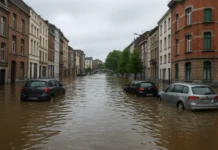Denmark is renowned for its strong economy, outstanding welfare system, and high standard of living. With picturesque cities, progressive policies, and a reputation for happiness, it seems like the perfect model of success. However, even this Nordic nation faces critical issues — from rising inequality and housing pressures to climate change and immigration tensions — that test its resilience and future growth.
This article examines the 10 major problems facing Denmark, supported by data and expert insights, to explain their causes and impacts on society.
Here Are The 10 Biggest Problems in Denmark
Housing Affordability Crisis
Despite Denmark’s economic strength, housing prices — especially in Copenhagen and Aarhus — have surged, making it increasingly difficult for young people and families to buy or rent homes. Tight supply and urban zoning limits intensify the concern, pushing many to commute long distances.Climate Change and Rising Sea Levels
As a low-lying country, Denmark is vulnerable to sea-level rise and coastal flooding. The government is investing heavily in climate adaptation, but extreme weather and erosion already affect agriculture, infrastructure, and coastal communities.Labor Shortages in Key Sectors
Despite its strong economy, Denmark experiences workforce shortages in healthcare, construction, and technology. An aging population and declining birth rates mean fewer workers to sustain public services and industry.Aging Population
Like many European countries, Denmark’s population is aging rapidly. The rise in retirees and decline in young workers are driving financial strain on Denmark’s welfare system, especially its pension and healthcare programs.Immigration and Integration
Denmark’s strict immigration policies have created ongoing debates about inclusion and national identity. Refugees and non-EU migrants often face barriers in employment and education, leading to social divides in positive communities.Mental Health and Stress
Despite being the “world’s happiest” nation, Denmark reports rising rates of depression and anxiety, particularly among youth. Even in an advanced society, growing academic pressure, workplace stress, and social isolation persist as pressing concerns.Income Inequality and Cost of Living
While Denmark remains egalitarian by global standards, economic inequality has been slowly widening. The high cost of living—particularly housing, energy, and food—places a heavy burden on middle- and low-income households.Energy Transition and Green Challenges
Denmark leads in wind power, yet it continues to face challenges in fully transitioning to renewable energy. Balancing industrial demands with environmental goals while reducing dependence on imported energy remains a complex issue.Rural Depopulation
Rural areas are steadily losing population as younger generations relocate to urban centers for career and educational prospects. This urban–rural divide leads to empty schools, declining services, and weakened local economies.Cybersecurity and Digital Dependence
As one of Europe’s most digitized societies, Denmark faces growing risks of cyberattacks targeting banks, healthcare, and government systems. The push toward a cashless, online economy makes resilience and security vital national priorities.
Key Economic Indicators of Denmark
| Indicator | Latest Data (2025 est.) | Notes |
|---|---|---|
| GDP Growth Rate | ~2.0% | Stable but slower due to the global slowdown |
| Unemployment Rate | ~4.5% | Among the lowest in the EU |
| Inflation Rate | ~2.1% | Moderating after energy spikes |
| Public Debt | ~32% of GDP | Relatively low, sustainable |
| Population Over 65 | ~20% | Aging trend increasing |
| Youth Unemployment | ~9% | Higher than the Nordic average |
| CO₂ Emissions per Capita | ~5.5 tons | Declining, but targets tightening |
Frequently Asked Questions (FAQs)
Why are housing prices so high in Denmark?
Limited urban space, high construction costs, and strong demand in cities like Copenhagen have driven prices up significantly.
How does climate change affect Denmark?
Sea-level rise and extreme weather threaten agriculture, infrastructure, and coastal areas, prompting major adaptation projects.
Why are there labor shortages in Denmark?
Low birth rates, an aging population, and high skill requirements in key sectors have created persistent job gaps.
What is Denmark doing to become more sustainable?
The government invests in offshore wind, carbon capture, and sustainable city planning to achieve carbon neutrality by 2040.
Authoritative Sources for Denmark’s Biggest Problems
| # | Problem | Annotation |
|---|---|---|
| 1 | Housing Affordability | Discusses urban housing shortages and price inflation in Denmark’s major cities. |
| 2 | Climate Change | Provides data on sea-level rise and adaptation policies. |
| 3 | Labor Shortages | Highlights workforce gaps and skill demand in key industries. |
| 4 | Aging Population | Highlights demographic trends and the issues facing the pension system. |
| 5 | Immigration | Examines integration and employment of foreign nationals. |
| 6 | Mental Health | Provides data on stress, youth well-being, and access to healthcare services. |
| 7 | Income Inequality | Details changes in income distribution and living costs. |
| 8 | Energy Transition | Examines progress in renewable energy and the rollout of green policies. |
| 9 | Rural Depopulation | Explains demographic shifts and local economic impacts. |
| 10 | Cybersecurity | Describes growing risks and national digital defense initiatives. |
Conclusion
Denmark continues to inspire the world with its social welfare, advancement, and environmental leadership. However, even strong nations must confront challenges that threaten long-term stability — from housing and demographics to climate resilience. The key lies in sustaining equality, protecting vulnerable communities, and strengthening green growth for future generations.
- The 10 Biggest Problems in Greece
- The 10 Biggest Problems in Spain
- The 10 Biggest Problems in Russia















